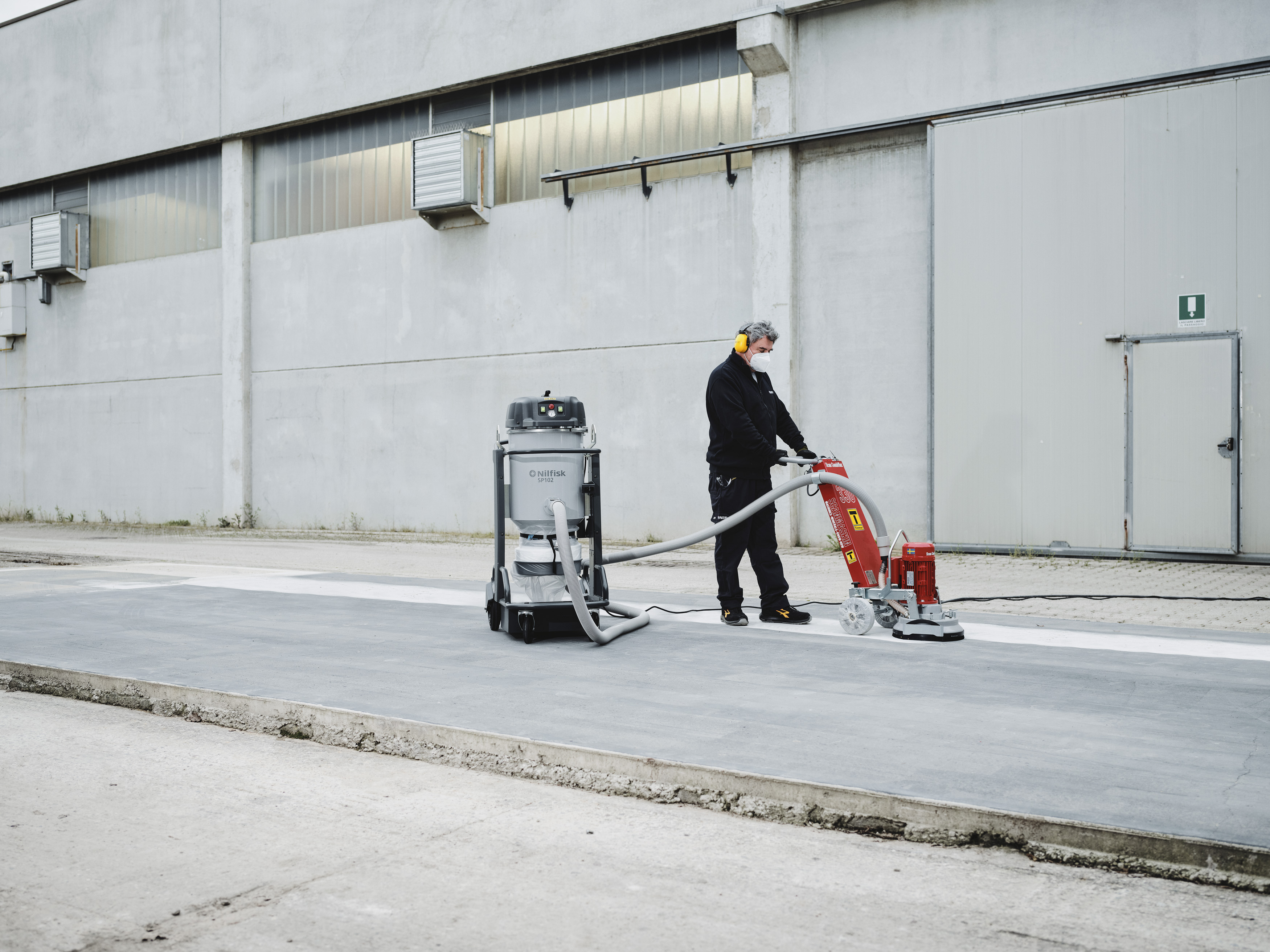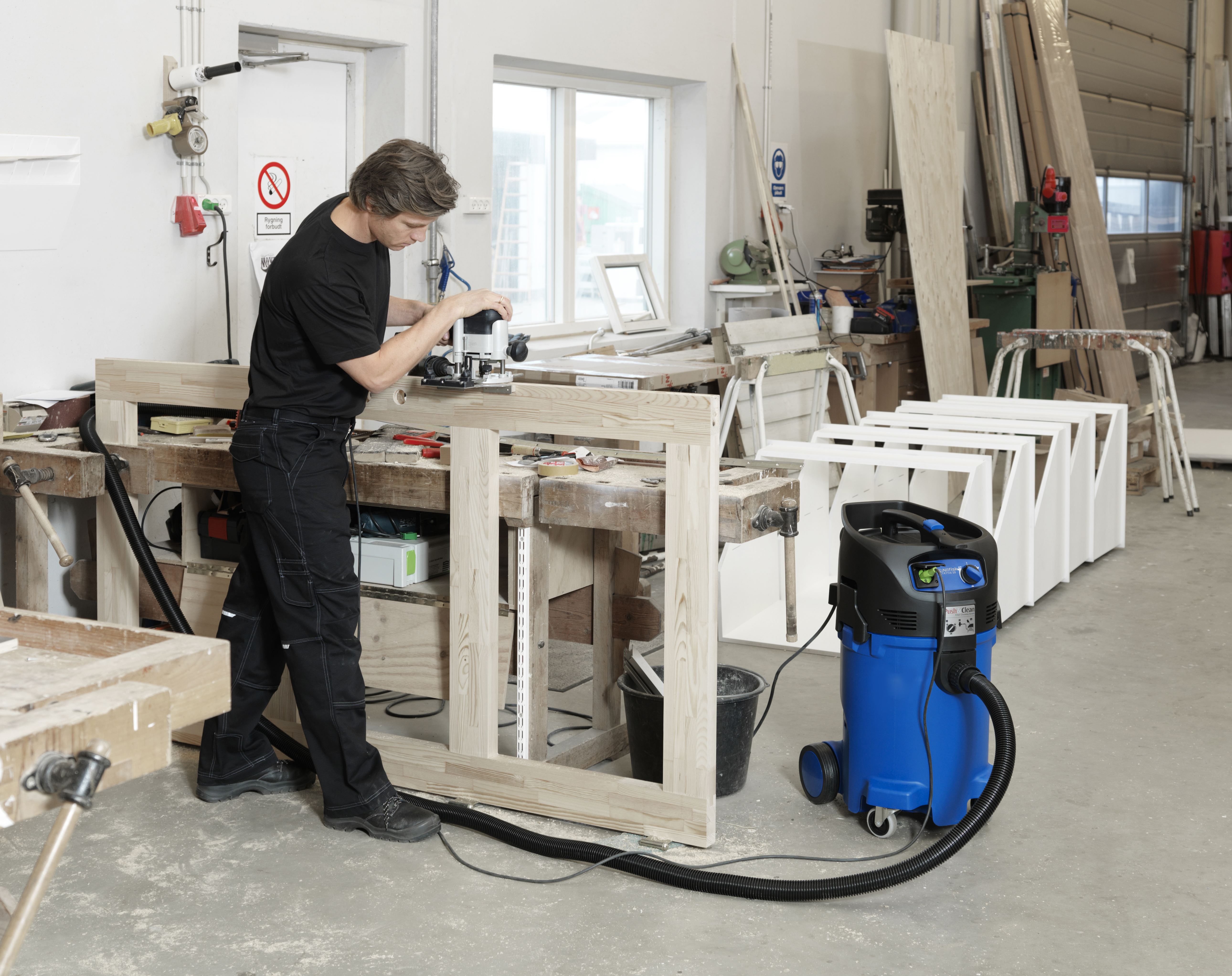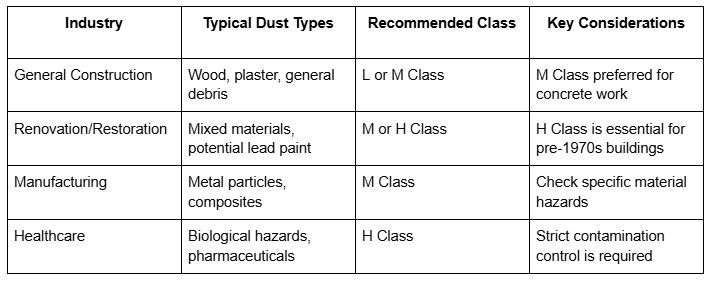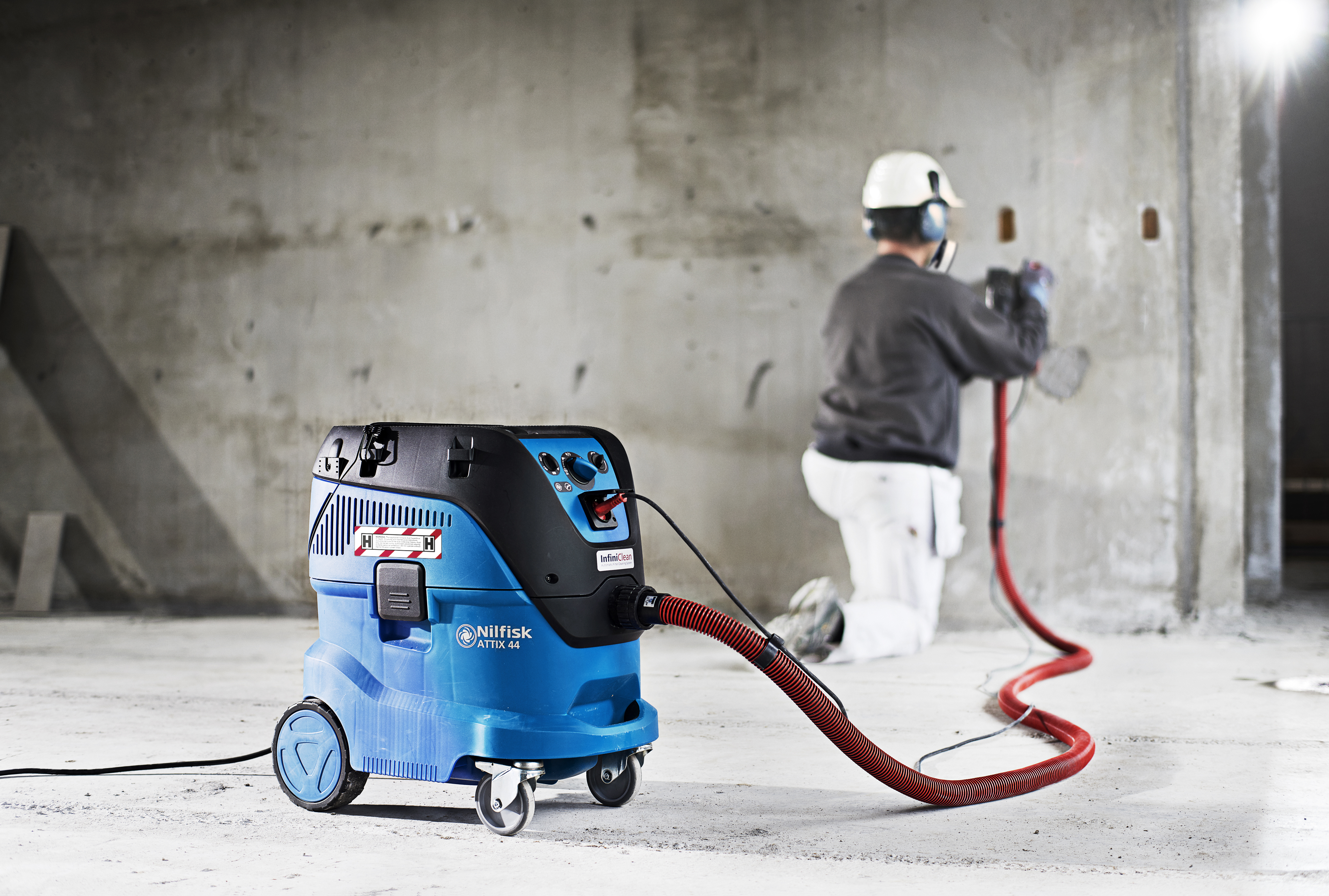Hazardous Dust Classes L, M & H Explained: How to Pick the Right Industrial Vacuum for COSHH Compliance
Why Getting Dust Classification Right Matters
It’s easy to overlook dust as just a nuisance – a by-product of cutting, grinding, or sanding that settles quickly and quietly. But in many industrial and construction environments, that fine layer of dust can pose serious health risks to workers and lead to non-compliance with UK safety regulations. Understanding how dust is classified — from low-risk to highly hazardous — is crucial for businesses seeking to protect their workforce, avoid fines, and comply with COSHH (Control of Substances Hazardous to Health) regulations.
The Control of Substances Hazardous to Health (COSHH) regulations exist precisely to protect your workforce from these invisible threats. As one industry expert puts it,
"COSHH stands for Control of Substances Hazardous to Health, and it is a must-have certificate for all relevant industries. COSHH regulations are in place to ensure the safety of employees, staff and other people in the workplace and eliminate or control the risk of exposure to hazardous substances and materials."
Getting your dust management strategy wrong doesn't just risk hefty fines - it puts your team's health on the line. From respiratory issues to long-term chronic conditions, the consequences of improper dust control can follow workers home and last a lifetime. That's why selecting the right industrial vacuum isn't just about ticking compliance boxes; it's about creating genuinely safer workplaces.
The financial implications are equally sobering. Non-compliance can result in unlimited fines, prosecution, and irreparable damage to your reputation. Yet with the right knowledge and equipment, achieving full COSHH compliance becomes straightforward and manageable.

Understanding COSHH Regulations and Dust Management
COSHH fundamentally changes how UK businesses must approach workplace safety. At its core,
"COSHH is a set of UK regulations designed to protect workers from hazardous substances. In simple terms, it's about identifying and controlling any substances that could harm people's health. This includes chemicals, dust, fumes, and even biological agents like bacteria and viruses."[S]
Your legal obligations under COSHH are clear-cut:
- Conduct thorough risk assessments for all dust-generating activities
- Implement adequate control measures to minimise exposure
- Provide appropriate personal protective equipment (PPE)
- Ensure proper training for all staff handling hazardous substances
- Maintain detailed records of assessments and control measures
- Review and update procedures regularly
Your risk assessment must identify what constitutes a hazardous substance in your specific workplace. According to regulations,
"A substance hazardous to health can include any material or mixture with the potential to cause harm when inhaled, ingested, or absorbed through the skin. The COSHH regulations apply to substances that are toxic, harmful, corrosive, or irritant, as well as dusts, biological agents, and other chemicals that present a health risk due to their properties or usage."{S}
Documentation isn't optional - it's your legal safety net. Keep detailed records of risk assessments, control measures implemented, staff training completed, and equipment maintenance schedules. These documents prove your commitment to compliance during inspections.
Hazardous Dust Classes Explained: L, M & H Classification System
The IEC 60335-2-69 standard provides the foundation for categorising industrial vacuums based on the hazardous dust they can safely handle. This isn't arbitrary classification - it's a carefully structured system designed to match vacuum capabilities with specific workplace risks.
The three dust classes break down as follows:
Hazardous Dust Classifications

Maximum Allowable Concentration (MAC) values determine which class you need. These values indicate the maximum concentration of dust particles permitted in workplace air. L Class handles dust with MAC values above 1 mg/m³, M Class covers 0.1-1 mg/m³, whilst H Class tackles anything below 0.1 mg/m³.
The filtration efficiency percentages seem marginally different, but that decimal point matters enormously. The jump from 99% to 99.995% filtration represents a massive reduction in harmful particles escaping back into your workplace air.
L Class Vacuums: When and Where to Use Them
L Class vacuums serve as the workhorses of many UK construction sites and workshops. They're designed for low-risk dust that, whilst still requiring proper management, doesn't pose immediate severe health risks.
Industrial L Class vacuum being used on a UK construction site with general construction debris
Suitable applications include:
- Wood processing facilities handling sawdust and shavings
- Plasterboard installation and renovation work
- General construction site cleanup
- Workshop maintenance in low-risk environments
- Educational facility workshop
Performance-wise, L Class vacuums must capture at least 99% of dust particles, which handles most non-toxic materials effectively. They typically feature robust motors designed for continuous operation, large-capacity dust bags for extended use between emptying, and standard filtration systems that are easy to maintain.
Cost considerations make L Class vacuums particularly attractive for businesses managing tight budgets. When you're cleaning large warehouse spaces or construction sites daily, these vacuums offer excellent value without compromising basic safety standards.
Maintenance keeps these workhorses running smoothly. Check filters weekly, replacing them according to manufacturer guidelines. Empty dust bags before they're completely full - overfilling reduces suction power and stresses the motor. Keep an eye on brush wear and replace worn components promptly to maintain optimal performance.
M Class Vacuums: The Sweet Spot for Many UK Workplaces
M Class vacuums represent the goldilocks zone for most UK businesses - not too basic, not excessive, but just right for handling the medium-risk dust encountered in typical industrial settings.
These vacuums excel at managing:
- Concrete dust from drilling and cutting operations
- Brick dust during demolition or renovation
- Mineral wool fibres in insulation work
- Ceramic tile dust from cutting and grinding
- Paint particles from sanding operations
The enhanced 99.9% filtration efficiency makes a substantial difference when dealing with finer particles that L Class vacuums might miss. Many M Class models incorporate automatic filter cleaning systems - a brilliant feature that maintains suction power throughout the workday by periodically clearing the filter of accumulated dust.

For UK workplaces, M-Class vacuums strike the perfect balance between protection and practicality. They're versatile enough to handle various tasks across the construction, manufacturing, and maintenance sectors. The investment typically offers substantial protection without the premium pricing of H Class units.
Safety precautions remain essential. Always ensure proper ventilation - UK guidance recommends
"General building ventilation should achieve five to ten air changes per hour. For specific processes, local exhaust ventilation (LEV) may be necessary to remove airborne contaminants at the source."
Train your team to recognise when dust levels exceed the vacuum's capabilities and never attempt to use M Class equipment for known carcinogenic materials.
H Class Vacuums: Maximum Protection for High-Risk Environments
When you're dealing with the most dangerous airborne particles, H Class vacuums become non-negotiable. These units represent the pinnacle of dust extraction technology, designed specifically for environments where even minimal exposure could have severe health consequences.
H Class applications include:
- Asbestos removal and remediation projects
- Lead paint removal in older buildings
- Pharmaceutical manufacturing cleanrooms
- Nuclear facility maintenance
- Healthcare environments handling biohazardous materials
The 99.995% filtration efficiency means these vacuums capture virtually everything - only 5 particles in 100,000 escape the filtration system. This extraordinary performance comes from multi-stage HEPA filtration combined with sealed systems that prevent any bypass of contaminated air.

Investment costs reflect this sophisticated engineering, with professional H Class units; however, when you consider the alternative - potential worker exposure to carcinogens - the investment becomes a bargain. Factor in the avoided costs of health claims, regulatory fines, and work stoppages, and H Class vacuums often pay for themselves through risk mitigation alone.
Common operational challenges include filter replacement costs (HEPA filters aren't cheap), weight and manoeuvrability (these units pack serious technology), and the need for specialised disposal procedures for collected materials. Address these by budgeting for consumables upfront, investing in units with transport wheels or mobile bases, and establishing clear protocols with certified waste disposal contractors.
Maintenance demands meticulous attention. Create detailed checklists for daily pre-use inspections, implement strict filter change schedules, and never compromise on genuine manufacturer parts. Document every service action - in high-risk environments, your maintenance records become crucial evidence of due diligence.
Practical Selection Guide: Matching Vacuum Class to Your Workplace
Selecting the right vacuum class starts with an honest assessment of your dust exposure risks. Here's a systematic approach:
Step 1: Identify Your Dust Types
Identify all materials in your operations that generate dust — not just from daily tasks, but also from occasional or infrequent activities. Be sure to consult the relevant Material Safety Data Sheets (MSDS) for detailed health hazard information.
Step 2: Determine Risk Levels
Classify each dust type according to its health impact. When in doubt, consult HSE guidelines or bring in a specialist assessor. Remember - it's always better to over-specify than under-protect.
Step 3: Consider Workspace Factors
Evaluate your workspace size, ventilation quality, and frequency of dust-generating activities. A small, poorly ventilated workshop might need higher-class equipment than a large, well-ventilated warehouse handling the same materials.
Step 4: Factor in Future Needs
Business growth often means taking on more challenging projects. Investing in M Class when L Class barely suffices today provides flexibility for tomorrow's opportunities.
Matching Vacuum Class to Industry

Staff training transforms good equipment into effective protection. Ensure every operator understands not just how to use the vacuum but why each feature matters. Create simple visual guides showing correct filter installation, proper emptying procedures, and warning signs of equipment problems.
Nilfisk Solutions: Innovation meets compliance & third-party certified assurance
Our vacuums are certified under key safety standards — including ATEX, ACD, Class II, Division 2, and the latest NFPA 660 and OSHA housekeeping requirements. These certifications verify that Nilfisk solutions are built to manage combustible and hazardous dust safely, reducing the risk of explosions and exposure, and supporting compliance with recognised health and safety frameworks. Here’s what each certification means:
ATEX certification
For use in explosive atmospheres where flammable gases or combustible dust may be present. ATEX-certified vacuums are designed to prevent ignition sources such as static electricity and overheating.
ACD certification
Focuses on the safe collection of combustible dust — even outside ATEX-classified zones — helping you stay compliant in less regulated but still risky areas. Class II, Division 2 Certification indicates that a vacuum is safe to operate in environments where combustible dust may be present under normal conditions. This is common in industrial or construction zones with ongoing processes that generate dust.
H-Class filtration
Used to designate equipment capable of safely collecting hazardous or toxic dust, including carcinogenic materials. These vacuums typically feature high-efficiency filters such as HEPA 14 or ULPA, which trap ultrafine particles and prevent re-release into the workspace.
Compliance with regulatory standards
Certified dust extraction systems help organisations meet international and regional safety requirements, such as: NFPA 660 (National Fire Protection Association), which combines and replaces older combustible dust standards with unified guidance for fire and explosion prevention. OSHA Housekeeping Requirements mandate control of dust accumulation in workplaces to minimise ignition hazards and protect worker health.
Advanced filtration and certified system design are essential for containing a wide range of dust hazard from fine powders like silica, flour, or pharmaceutical ingredients to larger debris like metal shavings or solvent-laden residues.
Why certification matters
Third-party certification ensures that dust extraction systems aren’t just functional — they’re tested and proven to perform in high-risk environments. For professionals in construction and building maintenance, using certified equipment provides peace of mind that the tools in place are fit for purpose and aligned with the latest safety expectations.
Local UK support means you're never alone with technical queries or service needs. Nilfisk's network of trained technicians understands UK workplace requirements and can guide in achieving and maintaining COSHH compliance. From initial selection through ongoing maintenance, you've got expert partners invested in your success. Contact Us
Making the Right Choice for Your Business
Selecting the right dust class vacuum isn't just about meeting regulations - it's about creating workplaces where your team can thrive safely. The key factors to remember:
- Assess your actual dust hazards honestly and thoroughly
- Match the vacuum class to your highest-risk applications
- Consider future needs alongside current requirements
- Establish vacuum certification status - self-certification v third-party certification
- Invest in proper training and maintenance protocols
- Document everything for compliance and continuous improvement
With regulatory changes and ongoing emphasis on workplace safety, now's the ideal time to review your dust management strategy. Whether you're upgrading ageing equipment or implementing new protocols, the right industrial vacuum forms the cornerstone of effective COSHH compliance.
Your next step? Conduct a thorough dust audit of your workplace. Identify gaps between current capabilities and compliance requirements. Then reach out to industry experts who can guide you toward the optimal solution for your specific needs. Your workers' health and your business's future depend on getting this right.
📞 Ready to Talk?
Contact Nilfisk today to book a free dust audit or dust extraction consultation. Let’s keep your team safe—and your operations compliant. Contact Us
